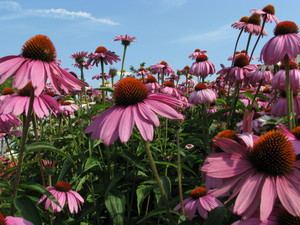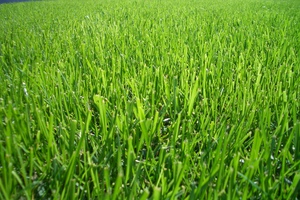Purple flower gardens are ideal for small yards as their color recedes into the landscape making a small yard appear larger. At the same time, the use of purple in flowerbeds makes the bed itself look larger. These cool colors create a calming or soothing effect, particularly if flowers are selected in adjacent colors on the color wheel. When working with purple flowers this means choosing purple or violet as the dominant color and adding purple blooms with bluish and reddish hues.
Color Intensity: Considering the Hue of Each Flower
Consider the hue of the blooms. Hue refers to the intensity of color from vibrant full color to subdued shades of the same color. For best results, all flowers should fall within the same range of intensity.
Adding Depth and Dimension
A monochromatic purple garden relies on the size, shape and texture of flowers for dramatic effect. Don’t forget to consider the effects of foliage on your garden. Variations in leaf size, shape and color add depth and dimension to the garden bed.
Cultural Needs
When planting a flowerbed the cultural needs of the individual flowers must be considered. Choose flowers that require the same lighting and watering. Determine the needs of individual plants and match it to the conditions of your flowerbed.
Selecting Flowers
Choose your dominant flower. Typically, this flower should be mid-range in height. One that grows 2 to 3 feet high allows you to accent with both shorter and taller flowers to add contrast and expand the range of flowers in the garden. Purple coneflower is an excellent choice as it grows upright and produces striking purple-pink blooms from midsummer until frost.
Select one or two taller varieties for the background of your bed and several mounding plants for the midsection. For the border of the bed, choose low growing plants. If you are planting in a raised bed or large container, adding trailing flowers along the border creates a free-flowing planting.
Consider breaking up color with white or yellow flowers. White will not detract from the color, but will add dimension to the garden. Flowers in the yellow-orange range create contrast and highlight purple creating a dramatic display of color.
Purple Flowers to Consider
Angelonia:This annual grows to heights of 12 to 28 inches and can be grown as a perennial in zones 9-11. Bloom size ranges from rich violet purple, white and purple bicolor, shades of purple-pink and pink. Blooms from midsummer until frost. Grow in full sun.
Balloon flower: This perennial is hardy in zones 3-9 and grows to heights of 12-24 inches. Blooms range from bluish-purple to pinkish-purple. Blooms from mid to late summer. Grows in full to partial sun.
Flossflower: This annual ranges in height from 6-inch varieties to massive 2-foot plants. Blooms resemble fuzzy pompoms and blooms from early summer to early fall. Colors range from violet to purple-pink and pink. Grows in full sun.
Flowering Tobacco: This annual reaches heights of 3 to 4 feet and spreads up to 2 feet. Blooms appear in midsummer and continue until early fall. Colors range from violet-red to deep red. Grows in full sun or partial shade.
Petunias: These prolific bloomers add a profusion of color from late spring until the fall frost. Available in a wide range of colors from rich blue-purple to shades of purple-pink with many bicolors in between. Plants grow to heights of 6 inches and sprawl to 2 feet or more. Grows in full sun.
Heliotrope: This long-blooming flower blooms from late spring until frost. Blooms appear on slender stalks above rich green foliage. Grows to heights of 1 to 2 feet. An annual in most areas of the U.S., it can be grown as a perennial in zones 9-11. Grows in full sun or partial shade.
Iris: This perennial creates a splash of color in late spring or early summer and ranges in color form pale blues and violets to rich hues of purple-red. Many are bi-colored and add a splash of yellow or white to lighten the garden. Varieties range in height from 6 inches to 3 feet. Grows in full sun.
Globe thistle: This perennial blooms from midsummer to fall and produces globe-shaped blooms. Colors include a range of subdued purples from nearly blue to those with pinkish hues. Grows to heights of 3 to 4 feet. Grows in full sun.
Purple coneflower: Hardy in zones 3 to 9, this perennial blooms from midsummer to fall with its dramatic daisy-like flowers that fold backward exposing a dark orange center. It grows to heights of 2 to 5 feet. Grow in full sun.





